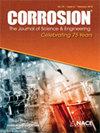Temperature Dependence of Adsorption and Effectiveness for a Pyrimidinium-Type Corrosion Inhibitor on Mild Steel
IF 1.3
4区 材料科学
Q4 MATERIALS SCIENCE, MULTIDISCIPLINARY
引用次数: 0
Abstract
In the oil and gas industry, produced water with high dissolved salt content is a common byproduct of hydrocarbon extraction from conventional and unconventional wells. Other than salts, corrosive gases such as CO2 are abundant in the production stream, which dissolve and acidify the solution, posing a risk of internal pipeline corrosion. To mitigate this issue, the injection of corrosion inhibitors has emerged as a cost-effective approach. In various aggressive conditions, heterocyclic molecules that contain nitrogen atoms have proven to be highly effective corrosion inhibitors for many alloys. In this study, tetrahydropyrimidinium (THP-C14) inhibition efficiencies were investigated at temperatures of 25, 55, and 80 °C using electrochemical methods, including linear polarization resistance and potentiodynamic sweeps. Corrosion inhibition data were then correlated with THP-C14 concentration, using the five adsorption isotherms: Langmuir, Temkin, Frumkin, Flory-Huggins, and Dhar-Flory-Huggins models. These isotherms utilize different assumptions to establish the correlation between coverage and inhibitor concentration. The suitability of these five isotherm models for describing the corrosion inhibition behavior of THP-C14 was examined. In addition, the thermodynamic parameters (Kad,ΔadGo) of adsorption for THP-C14 at 25, 55 and 80 °C were calculated and compared using the aforementioned adsorption isotherm models. Finally, a mechanism was proposed for the adsorption behavior of the THP-C14 corrosion inhibitor model compound. Chloride ions were important for inhibitor adsorption.一种嘧啶类缓蚀剂在低碳钢上的吸附性和有效性与温度有关
在油气行业,高溶解盐含量的采出水是从常规和非常规油井中提取碳氢化合物的常见副产品。除盐分外,生产流中还含有大量二氧化碳等腐蚀性气体,这些气体会溶解并酸化溶液,从而带来管道内部腐蚀的风险。为缓解这一问题,注入缓蚀剂已成为一种经济有效的方法。在各种腐蚀性条件下,含有氮原子的杂环分子已被证明是许多合金的高效缓蚀剂。本研究采用电化学方法(包括线性极化电阻和电位扫描)研究了四氢嘧啶(THP-C14)在 25、55 和 80 °C 温度下的缓蚀效率。然后使用五种吸附等温线将缓蚀数据与 THP-C14 浓度相关联:Langmuir、Temkin、Frumkin、Flory-Huggins 和 Dhar-Flory-Huggins 模型。这些等温线利用不同的假设来建立覆盖率与抑制剂浓度之间的相关性。研究了这五种等温线模型对描述 THP-C14 缓蚀行为的适用性。此外,还利用上述吸附等温线模型计算并比较了 THP-C14 在 25、55 和 80 °C 下的吸附热力学参数 (Kad、ΔadGo)。最后,提出了 THP-C14 缓蚀剂模型化合物的吸附行为机理。氯离子对抑制剂的吸附非常重要。
本文章由计算机程序翻译,如有差异,请以英文原文为准。
求助全文
约1分钟内获得全文
求助全文
来源期刊

Corrosion
MATERIALS SCIENCE, MULTIDISCIPLINARY-METALLURGY & METALLURGICAL ENGINEERING
CiteScore
2.80
自引率
12.50%
发文量
97
审稿时长
3 months
期刊介绍:
CORROSION is the premier research journal featuring peer-reviewed technical articles from the world’s top researchers and provides a permanent record of progress in the science and technology of corrosion prevention and control. The scope of the journal includes the latest developments in areas of corrosion metallurgy, mechanisms, predictors, cracking (sulfide stress, stress corrosion, hydrogen-induced), passivation, and CO2 corrosion.
70+ years and over 7,100 peer-reviewed articles with advances in corrosion science and engineering have been published in CORROSION. The journal publishes seven article types – original articles, invited critical reviews, technical notes, corrosion communications fast-tracked for rapid publication, special research topic issues, research letters of yearly annual conference student poster sessions, and scientific investigations of field corrosion processes. CORROSION, the Journal of Science and Engineering, serves as an important communication platform for academics, researchers, technical libraries, and universities.
Articles considered for CORROSION should have significant permanent value and should accomplish at least one of the following objectives:
• Contribute awareness of corrosion phenomena,
• Advance understanding of fundamental process, and/or
• Further the knowledge of techniques and practices used to reduce corrosion.
 求助内容:
求助内容: 应助结果提醒方式:
应助结果提醒方式:


